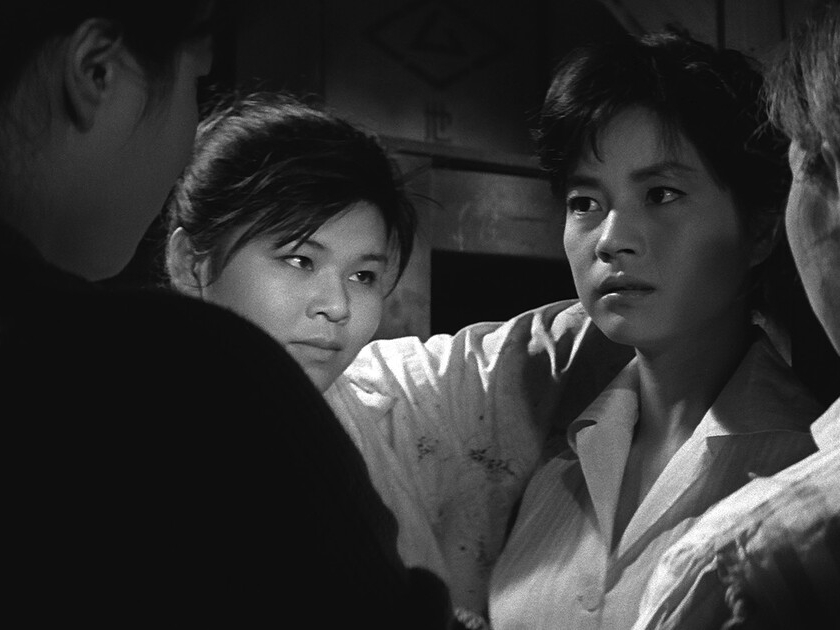
After the 1956 Prostitution Prevention Law was passed in Japan and hundreds of sex workers were arrested and sent to reformatories, former sex worker Kuniko tries to assimilate into the workforce as the prejudices against her past keep following her.
“In a confrontation with the Shiragiku director, Kuniko demands to know what makes sex work worse than other forms of labor. What difference is there, she asks, between selling one’s body and ‘[selling] your brains and freedom for a salary’? The director confesses that she’s not so sure herself, and Kuniko lets out an excruciating cry because she knows that though she is right she will always be seen as wrong.”
Kelley Dong1
“Perhaps because she lived so much of her life in the movies, she was drawn, as a director, to the innately cinematic effects of everyday spaces and actions. She liked to place her camera outside the threshold of a room, so that the sliding shoji screens of Japanese homes functioned like wipes, gracefully revealing or concealing the scene within.”
Imogen Sara Smith2
Kinuyo Tanaka: [...] Until now there have been two times in my life in which I’ve thought ‘Should I stop doing films?’, and the second one was when I became a director and much was said about it. Being a woman is just so… But no, actually the reason was not the fact of being a woman, but that I had no confidence in myself.
Kashiko Kawakita: That’s remarkable; to overcome all that.
Kinuyo Tanaka: However, trying to combine both, acting and directing, can be a problem. In the future, my career will gradually come to an end. But in your case, Mrs. Takamine, you are still fine.
Hideko Takamine: Please, don’t say such things. I’m also approaching the end of my career.
Kinuyo Tanaka: In my case, the fact is that I wasted the most productive period of my career due to the pause caused by the war. Because in the cinema world, one or two years is a long time. So after the war I tried to make up for those lost years all at once. This feeling was also at the base of my decision to become a director. As in the case of Mrs. Takamine, the thirties is the most productive age for an actress and also the time for succeeding as a person. I guess directing is my way of rebelling against having lost such an important time period.
Kinuyo Tanaka in conversation with Kashiko Kawakita, Hideko Takamine and Yamamoto Kyōko3
“Having never married, Tanaka liked to say that she was instead married to cinema. Cinema was one of her oldest and closest friends, their histories intertwined. After being harshly scolded by a teacher at the age of nine, she dropped out of school and started acting for Shōchiku Studios at fourteen. Her popularity boomed in the 1930s following a lead role in Japan’s first feature-length sound film, The Neighbor’s Wife and Mine (1931). Soon Tanaka’s fame had increased to such a degree that she was playing characters named after herself in films like The Story of Kinuyo (1930) and Kinuyo’s First Love (1940). An even higher apex was reached during the postwar Golden Age of Japanese cinema, when Tanaka left Shōchiku and became a freelance actress. She forged long working relationships with multiple illustrious auteurs, starring in films by Keisuke Kinoshita; Yasujirō Ozu; Mikio Naruse; and Kenji Mizoguchi, who cast her in fifteen of his films. [...] By the end of her life, Kinuyo Tanaka starred in over 250 films.”
Kelley Dong4
- 1Kelley Dong, “The Right to Refuse: The Films of Kinuyo Tanaka”, Notebook, 2022.
- 2Imogen Sara Smith, “Married to Cinema: The Films of Kinuyo Tanaka”, Film Comment, 2022.
- 3Kinuyo Tanaka, Kashiko Kawakita, Hideko Takamine and Yamamoto Kyōko, “Roundtable: the Position of Women in Film”, Kinema Junpō, No. 283, April 1961: 65-68.
- 4Kelley Dong, “The Right to Refuse: The Films of Kinuyo Tanaka”, Notebook, 2022.

